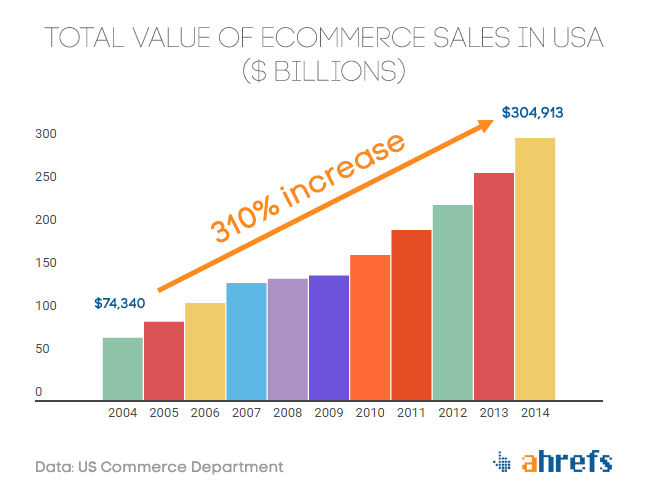Ecommerce has been growing at an exponential rate over the past decade or so. In 2014, in the United States alone, ecommerce sales reached well “past $300 billion — a growth of 310% in just 10 years.” With such a big market for opportunity, ecommerce businesses must learn how to compete in a saturated marketplace in order to flourish and stand out.
By utilizing a combination of best practices for both SEO and ecommerce, businesses can increase website visitor traffic significantly, along with successfully optimizing for specific products that are likely to result in the highest profits. While this sounds like a simple strategy, it actually involves a lot of complex steps to achieve the results you’re looking to accomplish.
Whether you’re starting a new ecommerce website from scratch, or just trying to revamp your existing site to increase sales, there are a few ecommerce SEO trends that we’ve seen work in 2016, that we think are worth sharing:
Ecommerce SEO Trends From 2016
1. Strategic Keyword Research
In order to run a successful ecommerce SEO campaign, you must begin with creating a keyword strategy. By doing strategtic keyword research and ensuring those are being used throughout your website, search engines will better undestand what you are trying to sell, which in turn can increase traffic and sales.
Choosing the right keywords is key. Look for keywords that are specific and relevant to the products you are selling, but also think what your potential customers are typing into the search engines to find those products. Look for keywords that have a lot of monthly traffic, but low competition, as it will be much easier to rank for those keywords.

In ecommerce, long tail keywords (three or more words) are extremely important because they tend to be very specific and depicts exactly what the user is searching for. It also can be an indicator that they are further along in the buyer cycle and more inclined to convert. According to SEOMoz, “longtail keywords make up over 70% of online searches” so it makes sense to make sure they are part of your keyword strategy, right?
There are many tools out there to assist you with your ecommerce keyword research. One of my favorite tools is the Google Adwords: Keyword Planner, but there are many other options worth looking into such as WordStream and KeywordTool.io.
2. Effective Categorization
When building an ecommerce website, it is crucial to develop a way of categorizing products and services that is highly intuitive to your visitors. You want make sure you are seamlessly guiding them to what they are looking for, as well as giving them what they are expecting. If your category structure is too complex or confusing, users are more apt to go elsewhere because their shopping experience took too long and they become frustrated. Try to keep things as simple as possible, without cutting corners. Trust me, your visitors and search engines will appreciate it.
3. Consistent Tracking
One of the most effective ways to measure your SEO results for your ecommerce website is by consistently tracking your website performance. By paying attention to what’s working and what isn’t, you can make the necessary changes and improve performance over time. If you don’t know where you started or what goals you’re trying to achieve, it becomes a lot more difficult to determine your rate of success.
4. Product Photos and Content
In a world where digital media has become the norm, it is absolutely critical that your online marketplace includes high quality images of your products, accompanied by high quality and relevant content. Your product descriptions should be as detailed as possible and answer any and all questions your visitors may have about your products. The more questions you answer for potential customers without having them to work for it, the less likely they are to go elsewhere to make their purchase.
Another great way to answer those unknown questions users might have, is to include a Q&A section on each product page. This allows anyone who is familiar or has used the product to answer. Having a third party answer questions and review your product, builds credibility, as well as helps you improve customer service/satisfaction.

5. META TAGS and Breadcrumbs
Meta tags are “snippets of text that describe a page’s content; the meta tags don’t appear on the page itself, but only in the page’s code.” Since search engines cannot read images and text on the page, it’s important to use meta tags to improve accessibility and SEO optimization, because it allows search engine spiders crawling your site to understand.
If you have a fairly large ecommerce website that organizes content hierarchically, using breadcrumbs is another way in which you can help search engines and users trying to find their way around your site.
6. Social Listening and Engagement
If you aren’t listening to what people are saying about your brand, and participating in the conversation, then you risk losing control of your reputation. It isn’t just about how many followers you have on social networks. It’s about how users engage with your brand and vice versa, as well as how Google sees the relevance of your business and its products based on your social interactions.
You don’t have to spend a ton of time on social media efforts to see results. By simply monitoring your audience and asking customers to review your products, share photos and stay engaged with your brand, you can significantly improve your company’s digital visibility and reputation. Also, make sure you pay attention to what users are saying about you, good and bad, and respond in a timely manner. There are plenty of tools you can use to assist you. A few of my favorites are: Hootsuite, Buffer, TweetDeck, Mention and Social Mention.
7. SEO Automation Technology
You don’t have to spend a lot to achieve SEO success and drive targeted traffic to your website. There are several ecommerce SEO tools, such as software, platforms, apps and widgets, that can be beneficial to achieving the ecommerce SEO results you want, without requiring much manual work. It goes without saying, however, that automated SEO efforts must be closely monitored and updated frequently to ensure the best results.
Unsure whether or not a manual or automated SEO strategy is right for you? Here is a pros and cons of manual vs automated SEO.
And those are our 2016 SEO trends! This is just a small sample of some of the most popular trends we’ve seen with SEO and ecommerce websites. If you’re wondering what Commonplaces can do for your ecommerce business, contact us today to learn more and feel free to leave your SEO tips in the comments! We love to hear what works (and what isn’t) for you and your business.



